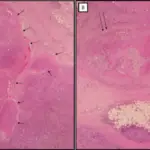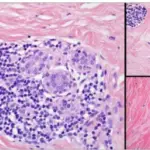Granulomatous mastitis is the inflammatory process of the breast usually due to Corynebacterium species.
What is the Pathology of Granulomatous mastitis?
The pathology of granulomatous mastitis is:
-Etiology: The cause of granulomatous mastitis inflammation and granulomas.
-Genes involved: 16S rRNA and rpoB gene sequencing.
-Pathogenesis: The sequence of events that lead to granulomatous mastitis is the nonspecific lobulitis, a granulomatous formation with central suppurative necrosis, abscesses, trauma, and non-puerperal secretion.
-Morphology: The morphology associated with granulomatous mastitis shows granulomas comprised of epithelioid histiocytes and giant cells with central lipid vacuoles containing bacteria and polymorphonuclear cells.
-Histology: The histology associated with granulomatous mastitis shows the lobulocentric mixed inflammatory infiltrate composed of lymphocytes, neutrophils, and scattered multinucleated giant cells.
How does Granulomatous Mastitis Present?
Patients with granulomatous mastitis typically are female. The symptoms, features, and clinical findings associated with granulomatous mastitis include a painful breast mass, nipple inversion or sinus formation.
How is Granulomatous Mastitis Diagnosed?
Granulomatous mastitis is diagnosed by microscopic examination and Gram stain with or without microbiologic culture.
How is Granulomatous Mastitis Treated?
Granulomatous mastitis is treated with antibiotics and steroids. Empirical antimicrobial therapy may be started prior to histologic diagnosis and lipophilic antibiotics, such as doxycycline, trimethoprim sulfamethoxazole, clarithromycin, and rifampicin. Surgery may involve incision, drainage, excision, or mastectomy.
What is the Prognosis of Granulomatous Mastitis?
The prognosis of granulomatous mastitis is fair.



